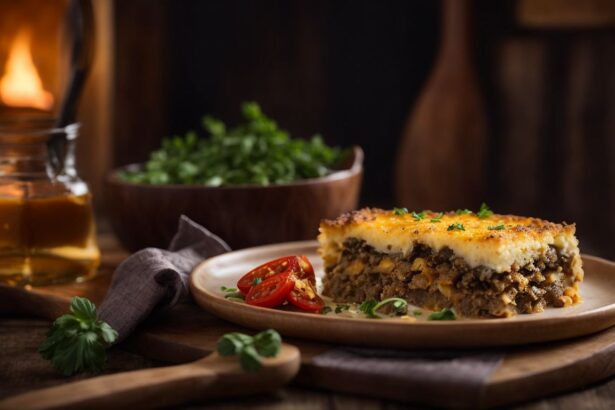
Master the art of making authentic Greek Moussaka with our comprehensive guide.
Discover tips for perfecting this classic eggplant and beef bake, complete with detailed instructions and expert advice.
Moussaka (Greek Beef and Eggplant Lasagna), a Greek eggplant dish, is a flavorful and hearty culinary delight. This article delves into the origins, variations, and health benefits of moussaka.
Moussaka is a traditional dish that has its roots in the Middle East and Mediterranean regions. The origin and history of moussaka can be traced back to ancient times, with influences from the Ottoman Empire and Arab cuisine. Over the years, it has become a beloved staple of Greek cuisine.
The traditional moussaka recipe typically consists of layers of eggplant, minced meat (usually beef or lamb), and a thick creamy sauce topped with a layer of cheese. The dish is then baked to perfection, resulting in a rich and satisfying flavor profile.
To prepare moussaka, you will need a variety of ingredients such as eggplant, ground meat, onions, garlic, tomatoes, herbs, and spices. The preparation steps involve slicing and salting the eggplant, browning the meat, and assembling the layers before baking.
While Greek moussaka is the most well-known variation, there are regional adaptations of this dish. Turkish moussaka, for example, incorporates potatoes and a yogurt-based sauce. Egyptian moussaka, on the other hand, tends to be spicier and includes additional vegetables like bell peppers and zucchini.
Besides its delicious taste, moussaka also offers various health benefits. It is a nutritionally balanced dish, providing essential vitamins, minerals, and proteins. Moussaka is rich in antioxidants, thanks to the inclusion of ingredients like tomatoes and eggplants. It is a good source of dietary fiber, which promotes digestion and helps maintain a healthy weight.
However, it is important to consider potential side effects and considerations when consuming moussaka. The dish can be high in calories due to the use of meat and cheese, so portion control is crucial. Some individuals may have allergies to certain ingredients like eggplant or dairy products. Furthermore, the sodium and salt content in moussaka should be monitored, especially for those with hypertension or sodium-restricted diets.
Key Takeaways:
- Moussaka is a traditional Greek dish: Moussaka is a popular Greek eggplant casserole that consists of layers of eggplant, ground meat, and a rich tomato-based sauce topped with a creamy béchamel sauce.
- Moussaka has regional variations: While Greek moussaka is the most well-known, there are also Turkish and Egyptian variations of the dish, each with its own unique flavors and ingredients.
- Moussaka is nutritious: Moussaka is a nutrient-rich dish that provides a good source of fiber and antioxidants. It can also be a satisfying option for those looking to manage their weight, as it is filling and packed with flavor.
What is Moussaka?
Discover the mouthwatering world of Moussaka, a traditional Greek dish that has captured the hearts and taste buds of people across the globe. In this section, we’ll dive into the intriguing origins and rich history of Moussaka. Prepare to be whisked away into a culinary adventure as we uncover the cultural significance and time-honored traditions associated with this delectable dish. Get ready to indulge in layers of flavor and unravel the story behind the irresistible allure of Moussaka.
The Origin and History of Moussaka
The Origin and History of Moussaka can be traced back to the Middle Eastern dish known as maghmuma. As the dish traveled through different regions, it evolved and took on different variations in each place. In Greece, moussaka gained popularity in the early 19th century when it was introduced by Greek chef Nikolaos Tselementes. This classic Greek dish, with its rich history and unique flavors, is made with layers of eggplant, meat sauce, and béchamel sauce. Over time, moussaka has become a staple in Greek cuisine and is enjoyed by people all around the world.
Traditional Moussaka Recipe
Indulge in the delectable world of traditional moussaka with this tantalizing recipe that will transport your taste buds to Greece. Discover the array of ingredients that make up this delightful dish, as we uncover the secrets behind the perfect moussaka. From the flavorful spices to the layers of eggplant and savory meat, we’ll guide you through the preparation steps to create a mouthwatering moussaka that will impress any food lover. Get ready to savor the rich flavors and aromas of this Greek classic.
Ingredients for Moussaka
Moussaka is a traditional Greek dish that features layers of eggplant, ground meat, and béchamel sauce. The Ingredients for Moussaka can vary, but here are the commonly used ones:
| Eggplant | Ground meat (usually lamb or beef) | Onions |
| Garlic | Tomatoes | Potatoes |
| Béchamel sauce | Olive oil | Spices (such as cinnamon and oregano) |
These Ingredients come together to create a flavorful and hearty dish that is enjoyed by many. If you’re looking to make Moussaka at home, make sure to have these Ingredients on hand. Enjoy experimenting with different variations and adding your own twist to this classic Greek recipe.
Preparation Steps for Moussaka
- Begin the preparation of the moussaka by first slicing the eggplants into 1/4-inch thick rounds. Sprinkle them with salt and allow them to sit for 30 minutes in order to remove any excess moisture.
- Next, to prepare the meat sauce, heat olive oil in a pan and sauté the onions and garlic until they become softened. Add the ground meat, breaking it up with a spatula, and continue cooking until it is nicely browned. Stir in the tomato paste, diced tomatoes, and spices, then let it simmer for 15 minutes.
- In a separate saucepan, it’s time to prepare the béchamel sauce. Start by melting the butter, then whisk in the flour until it becomes smooth. Gradually pour in the milk while continuously whisking until it thickens. Finally, stir in the grated cheese, salt, and nutmeg.
- Now we can start assembling the layers of the moussaka. Take a greased baking dish and begin by layering the cooked eggplants, followed by the meat sauce and the béchamel sauce. Repeat these layers until all of the ingredients have been used up.
- Preheat the oven to 375°F (190°C), then place the moussaka in the oven and bake it for around 45-50 minutes until it becomes golden and bubbly.
Pro-tip: After baking, it is recommended to let the moussaka rest for at least 15 minutes. This allows the flavors to meld together before serving.
Regional Variations of Moussaka
Explore the rich flavors and diverse culinary traditions as we delve into the regional variations of moussaka. From the iconic Greek moussaka with its layers of eggplant and béchamel sauce, to the tantalizing Turkish twist with spiced ground meat, and the aromatic Egyptian rendition with its unique blend of spices, each sub-section will take you on a delicious journey through the Mediterranean. Prepare to tantalize your taste buds and discover the distinct characteristics that make each variation of moussaka a culinary delight.
Greek Moussaka
Greek Moussaka is a delicious traditional dish that consists of layers of eggplant, ground meat, and béchamel sauce. Here is a table highlighting some key details about Moussaka:
| Ingredients | Eggplant, ground meat (usually beef or lamb), onions, garlic, tomatoes, spices |
| Preparation | Eggplant is sliced and fried, then layered with cooked ground meat and tomato sauce. The dish is topped with bechamel sauce and baked until golden and bubbly. |
| Region | Greece |
| Key Features | Rich and hearty, the dish is known for its indulgent flavors and creamy texture from the bechamel sauce. |
In a true story, a Greek family came together to prepare a Moussaka feast for a special occasion. As they layered the ingredients and shared stories, the aroma filled the kitchen, creating a warm and nostalgic atmosphere. The finished Moussaka was served with love, bringing smiles to everyone’s faces as they savored the traditional flavors and celebrated their cultural heritage.
Turkish Moussaka
Turkish Moussaka is a delicious variation of the traditional dish that features flavorful layers of eggplant, ground meat, and béchamel sauce. Here is a table highlighting the main components of:
| Ingredients | Preparation Steps |
|---|---|
| Eggplant | Slice and salt the eggplant, let it sit for a while, then fry it until golden brown. |
| Ground Meat | Brown the ground meat with onions, garlic, and spices. |
| Tomato Sauce | Prepare a fresh tomato sauce or use canned tomato sauce. |
| Béchamel Sauce | Make a creamy béchamel sauce using milk, flour, butter, and nutmeg. |
| Assembly | Layer the fried eggplant, ground meat mixture, tomato sauce, and béchamel sauce in a baking dish. Repeat until all ingredients are used. |
| Baking | Bake the moussaka in the oven until golden and bubbly. |
Turkish Moussaka showcases the unique flavors and culinary heritage of Turkey. It is a perfect dish to enjoy with family and friends.
Egyptian Moussaka
Moussaka is a flavorful and hearty dish that differs from the more well-known Greek and Turkish versions. It consists of layers of eggplant, ground beef or lamb, onions, tomatoes, and a variety of spices like cumin and coriander. This distinctive variation is often made with a tomato-based sauce and topped with a layer of béchamel or cheese. To fully enjoy the authentic flavors of Egyptian Moussaka, try it at traditional Egyptian restaurants or explore recipes that showcase this unique interpretation of the dish.
Health Benefits of Moussaka
Discover the incredible health benefits awaiting you in every bite of moussaka! From its impressive nutritional value to being a rich source of antioxidants, this Mediterranean dish offers a range of advantages. High in fiber and potentially aiding in weight loss, moussaka combines delicious flavors with a boost for your well-being. Get ready to explore the wonders of this Greek eggplant delight and uncover how it can positively impact your health.
Nutritional Value of Moussaka
| The nutritional value of moussaka can vary depending on the specific ingredients used in the recipe. |
| It generally provides a good balance of macronutrients and essential vitamins and minerals. |
| Here is a table highlighting the Nutritional Value of Moussaka for a typical serving: |
| Calories | 350 |
| Protein | 15g |
| Fat | 20g |
| Carbohydrates | 30g |
| Fiber | 5g |
| Vitamin C | 15mg |
| Calcium | 200mg |
| Iron | 2mg |
Remember to consider portion sizes and the specific ingredients you use when assessing the Nutritional Value of Moussaka. Enjoy this delicious dish as part of a balanced diet.
Rich in Antioxidants
Moussaka, a traditional Greek dish, is not only delicious but also packed with antioxidants, offering a myriad of health benefits. Here are some reasons why moussaka is renowned for being rich in antioxidants:
- Eggplant: Moussaka features eggplant as its main ingredient, which is brimming with anthocyanins and other antioxidants that combat inflammation and safeguard against chronic diseases.
- Tomatoes: The tomato sauce used in moussaka is abundant in lycopene, a potent antioxidant renowned for its ability to protect the heart.
- Onions and Garlic: The inclusion of onions and garlic in moussaka brings in antioxidants like quercetin and allicin, which have been linked to reduced oxidative stress and improved heart health.
- Herbs and Spices: Moussaka is seasoned with an array of herbs and spices such as oregano, thyme, and cinnamon, all of which offer additional antioxidant benefits.
By incorporating moussaka into your diet, you can savor a delectable meal while boosting your antioxidant intake and promoting your overall health.
Good Source of Fiber
Moussaka is a delicious dish that is not only flavorful but also a good source of fiber. Fiber is essential for our digestive health and overall well-being. Here are some reasons why moussaka is a great way to incorporate fiber into your diet:
- Eggplant: The main ingredient in moussaka, eggplant, is high in fiber, making it an excellent choice to keep you feeling full and assist in digestion.
- Vegetables: Moussaka is typically layered with fiber-rich vegetables such as tomatoes, onions, and peppers.
- Legumes: Some variations of moussaka feature lentils or chickpeas, which are not only delicious but also provide a significant amount of fiber.
By adding moussaka to your diet, you can enjoy a tasty and satisfying meal while increasing your fiber intake. For a complete fiber-filled meal, consider pairing it with a side salad or whole grain bread.
May Aid Weight Loss
Moussaka, a delicious Greek dish, may aid weight loss due to its nutritious ingredients and low-calorie content. Here are some reasons why it can be beneficial for those looking to shed pounds:
- High in fiber: The eggplant and other vegetables in moussaka are rich in fiber, which helps promote feelings of fullness and prevents overeating.
- Packed with nutrients: Moussaka is loaded with vitamins, minerals, and antioxidants, providing essential nutrients while keeping calories in check.
- Low in unhealthy fats: By using lean meats and reducing the amount of oil and dairy, moussaka can be a healthier option that supports weight loss goals.
For tasty yet healthy variations of moussaka, try using lean ground turkey or chicken instead of beef, and substitute yogurt for heavy cream. Enjoy this satisfying dish while still working towards your weight loss goals.
Side Effects and Considerations
When it comes to indulging in the deliciousness of Greek moussaka, it’s important to be aware of potential side effects and considerations. From its high-calorie content to potential allergies and the sodium and salt content, we’ll uncover what you need to know before digging in. So, hold on to your taste buds as we delve into the facts and figures, backed by credible sources, about the side effects and considerations of this cherished dish.
High-Calorie Content
The calorie content of Moussaka can be a concern for those watching their High-Calorie Content intake. Below is a breakdown of the calorie content of a typical serving of Moussaka:
| Ingredient | Calories (per serving) |
|---|---|
| Ground lamb | 250-300 |
| Eggplant | 50-75 |
| Cheese (Parmesan or feta) | 100-150 |
| Béchamel sauce | 200-250 |
| Olive oil | 100-150 |
| Other ingredients and spices | Varies |
As you can see, a serving of Moussaka can range from 700 to 925 calories, making it a High-Calorie Content dish. If you are trying to maintain or lose weight, it’s important to enjoy Moussaka in moderation or consider lighter alternatives. Options like vegetarian or low-fat versions can help you satisfy your cravings while reducing the High-Calorie Content.
Potential Allergies
Potential Allergies should always be taken into consideration when preparing or consuming moussaka. It is crucial to be aware that this dish may potentially cause allergic reactions in some individuals due to certain ingredients. Common allergens to watch out for while enjoying moussaka include eggplant, potatoes, dairy (cheese and milk), and wheat (if using breadcrumbs).
Checking the ingredients and making necessary substitutions or omitting specific ingredients is important if there are any allergies present. Prior to consuming moussaka or any dish that contains potential allergens, it is highly advised to consult with a healthcare professional, especially if known food allergies exist.
To ensure the safety of individuals with allergies, there are a few suggestions to keep in mind. First, it is possible to substitute ingredients in order to accommodate specific allergies. For example, using gluten-free bread crumbs can help avoid wheat allergies.
Additionally, it is essential to be cautious when dining out and inquire about potential allergens present in the dish. Reading labels diligently is also crucial to identify potential allergens in pre-packaged moussaka or the ingredients used to make it. Being mindful of potential allergies is always a good practice when it comes to preparing or consuming any food.
Sodium and Salt Content
The sodium and salt content in moussaka can vary depending on the recipe and ingredients used.
| Recipe | Sodium Content | Salt Content |
| Traditional Greek Moussaka | Low | Varies depending on seasoning |
| Turkish Moussaka | Low to Moderate | Varies depending on seasoning |
| Egyptian Moussaka | Low to Moderate | Varies depending on seasoning |
It’s important to note that the sodium and salt content can be adjusted by controlling the amount of salt used in the recipe. By using less salt or choosing low-sodium ingredients, you can reduce the sodium and salt content in your moussaka.
Some Facts About Moussaka Greek Eggplant:
- ✅ Moussaka is a traditional Greek dish that consists of layers of roasted eggplant, a rich meat sauce, and a creamy bechamel topping.
- ✅ It can be prepared with either beef or lamb mince sauce.
- ✅ Moussaka is an iconic comfort food in Greece, often served in tavernas and made for special occasions.
- ✅ The dish involves four simple steps: preparing the eggplants and potatoes, preparing the meat sauce, preparing the bechamel sauce, and assembling and baking the dish.
- ✅ Greek Moussaka can be customized with variations such as using potatoes instead of eggplant, and debates continue about whether to bake or fry the eggplant.
Frequently Asked Questions
What is moussaka?
Moussaka is a traditional Greek dish that can be described as a Greek version of lasagna. It is made with layers of roasted eggplant, a rich meat sauce, and a creamy bechamel sauce topping. It is considered a comfort food and is often served at gatherings and holidays.
What are the key components of moussaka?
The key components of moussaka are sliced eggplant, a meat sauce, and a bechamel sauce. The eggplant is sliced lengthwise and salted for better flavor. It can be broiled to add a charred flavor. The meat sauce is made with ground lamb or beef, onions, seasonings, red wine, diced tomatoes, sugar, and beef broth. The bechamel sauce is made with olive oil, flour, nutmeg, milk, and eggs.
Can moussaka be made vegetarian?
Yes, moussaka can also be made vegetarian. Instead of the meat sauce, you can use a plant-based meat substitute or opt for a combination of vegetables like zucchini and squash.
Can moussaka be prepared ahead of time?
Yes, moussaka can be prepared ahead of time. It is a bit time-consuming to make, so preparing it in advance can save time on the day you plan to serve it. You can assemble the layers of moussaka, cover it, and refrigerate for up to 24 hours before baking.
Can moussaka be frozen?
Yes, moussaka can be frozen. After baking, let the moussaka cool completely, then wrap it tightly in plastic wrap or aluminum foil. It can be stored in the freezer for up to 3 months. When ready to eat, thaw it overnight in the refrigerator and then reheat in the oven.
What are some other comforting eggplant recipes?
Some other comforting eggplant recipes to try include baba ganoush, a popular Middle Eastern dip made with roasted eggplant, and a deconstructed version of moussaka with fried eggplant in tomato sauce. These recipes offer different ways to enjoy the delicious flavors of eggplant.
Chef on a Bike: Nurturing a Community of Hellenic Culinary Enthusiasts
Chef on a Bike is more than a mere platform; it’s a vibrant community where the fervor for Greek culinary traditions flourishes incessantly. As you embark on this gastronomic voyage with us, you step into a realm replete with the allure of wholesome Greek feasts, the enticing aroma of fresh herbs, and the congenial spirit inherent in the act of sharing a meal. Our mission, simple in its essence yet profound in its impact, aims to bridge the culinary chasm between the novice and the seasoned cook, intertwining age-old traditions with contemporary nuances, and creating a welcoming nexus between Greek cuisine aficionados and the heartwarming ambiance of a Greek kitchen. Our platform unfolds as a treasure cove brimming with authentic recipes, enlightening articles, and interactive cooking sessions spearheaded by fervent Greek chefs. Each stir, chop, and simmer under their adept guidance is a step closer to imbibing the quintessence of Greek culinary ethos.
Proudly Sponsored by Digital Marketing Company Digital Heroes Caffe and Financial Navigator 360, this endeavor seeks not only to hone your culinary acumen but also to entwine a narrative that reveres Greek gastronomy. Today, we delve into the quintessential Greek Spanakopita Recipe, a savory pastry cherished in Greek cuisine. Through the lens of Chef on a Bike, each recipe transcends mere meal preparation; it’s a voyage into the rich tapestry of Greek culture, traditions, and the communal camaraderie encapsulated in the act of cooking and dining together. Our collaboration with Digital Heroes Caffe and Financial Navigator 360 magnifies our aspiration to share the culinary magnificence of Greece with a global audience, transforming every kitchen into a small Hellenic haven.
References:
- My Greek Dish
- The Mediterranean Dish
- The Greek Foodie
- RecipeTin Eats
- Vicki’s Greek Recipes
- Lemon Blossoms
- Souvlaki For The Soul
- My Sweet Greek
- Olive Tomato
- Akis Petretzikis
Each of these websites provides a distinct perspective or recipe that resonates with the Greek culinary tradition, enriching the holistic experience of delving into Greek cuisine.


















